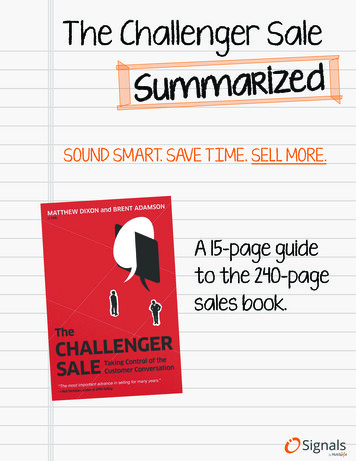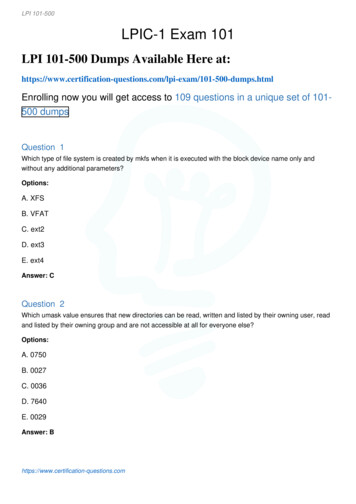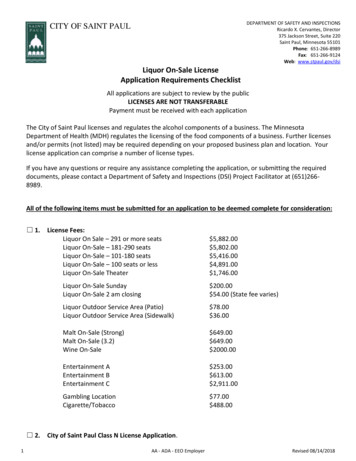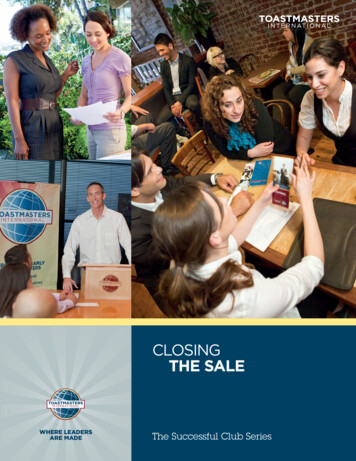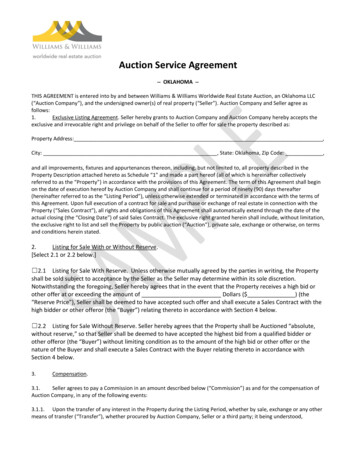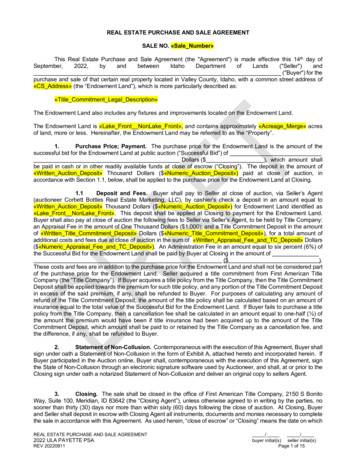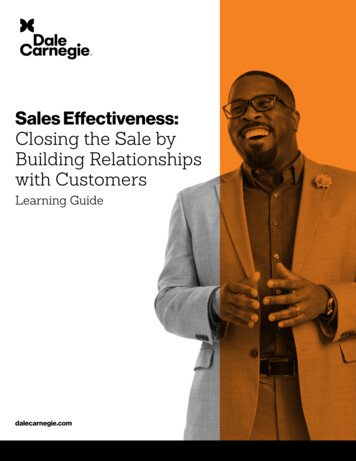
Transcription
Sales Effectiveness:Closing the Sale byBuilding Relationshipswith CustomersLearning Guidedalecarnegie.com
dalecarnegie.comLearning GuideClosing the Sale byBuilding Relationships with CustomersDale Carnegie said, “So if you aspire to be a good conversationalist, be an attentive listener. To beinteresting, be interested. Ask questions that other persons will enjoy answering.”It’s your first meeting with a new prospect. You’re excited to share all your new products and services,and you’re sure they will like what you have to offer. You’ve prepared a powerful presentation thatshowcases you, your company and your products. And you’re poised and ready with everything youcould possibly need to close a sale. CUT! Hold it right there!You cannot prepare a customized presentation for a client without first asking open-ended questionsand then actively listening to their answers. Your first meeting with a new client is the time for you toprobe, and to discover and consider solutions (in your head) to their particular concerns. People liketo talk. LET THEM.Clients today are prepared. They’ve already been on your website. They’ve seen your products, yourpromotions and your customer reviews. They’ve been on your competitor’s websites too, offeringthe same products for the same prices. But savvy sales executives are doing something that theInternet cannot do: they are building relationships. They are committed to the success of their client.They understand that enduring partnerships are the key to positive outcomes for everyone. A lastingbusiness relationship is built one conversation at a time, and it all begins with attentive listening.“Thousands of salespeople are pounding the pavements today,tired, discouraged and underpaid. Why? Because they arealways thinking only of what they want. They don’t realize thatneither you nor I want to buy anything. If we did, we would go outand buy it.”- Dale Carnegie
Learning Guidedalecarnegie.com5 Steps to Building the CustomerRelationshipDale Carnegie Training is the leader in developing sales professionals who canleverage relationship selling to exceed quotas, expand deals, and develop a reliableand sustainable pipeline of business.1CreateValue2Facts andBenefitsCustomers want to know what you can do for them, whether that is solving theirproblems or helping them capitalize on new opportunities. To provide value, youmust first understand what your customers truly want. This involves active listening,as stated before, but also intelligent questions. Intelligent questions require research.You owe it to your prospect, who has committed the time to talk with you. The depthof your research depends on your industry and the size and complexity of thepotential sale – but in this age of information, there is no excuse for not having doneit. Once your research is completed, you’re in a better position to view things fromthe customer’s perspective. That will help you determine where you can provide themost value.Facts and benefits are one way to provide value, but many times sales professionalsrely too heavily on them. As a result of your intelligent questions and active listening,you should understand whether a customer has visited your website, what they’velearned and what their initial impression is. You can then tailor your approach indelivering additional information about your products or services to respect theprospect’s time and add to – not repeat - what they already know. As Dale Carnegiesaid, “Merely stating a truth isn’t enough. The truth has to be made vivid, interestingand dramatic.” A great way to bring to life the facts, benefits and solutions yourproduct or service offers is to tell a story – and it also makes it much easier for yourcustomer to remember. In the Dale Carnegie Sales Training program, we teach aquick and easy way to develop and deliver a story with confidence and ease.Remember that facts are specific, true, provable statements and benefits are brief,clear descriptions of how customers could use and enjoy your solution or product.Always be prepared to back up your facts or statements with evidence.
Learning Guidedalecarnegie.com3QualifyingQuestionsHandle qualifying questions with care. While it may be tempting to qualify thecustomer right away, it’s important to not ask qualifying questions too early in theprocess because it can be off-putting to the potential buyer. That said, you don’twant to waste your time - or the customer’s - on a product or solution that simplyisn’t the right fit. Think about things from the client’s perspective and frame yourquestions in a way that will help answer the customer’s questions as well as yourown. This will reduce the amount of time spent setting appointments with peoplewho are unlikely to buy.Needs AnalysisBefore you offer your solution, discover what the customer truly needs. Askquestions and listen carefully to uncover their needs in the four key areas.4GainingCommitment Primary Interest: They want to buy the results your solution provides: enhancedeffectiveness, improved efficacy, safety, comfort and flexibility, etc. Buying Criteria: If the buying criteria are not met, the sale will not advance:features, budget, approvals, support, location and quality. Individual Motive: The compelling emotional reason for the customer to makethe buying decision: relationships, recognition, self-fulfillment, self-preservationand power. Risk vs. Reward Consideration: Compare the cost of no action against the payoffof action: paint a word picture.Paint a Word PicturePeople buy for a variety of reasons, including rational and emotional factors. A wordpicture is a memorable way to summarize the value of your solution while activatingthe buyer’s emotions, creating a sense of urgency and defeating procrastination.To successfully paint an effective word picture for your potential customer, youmust: Remind your customers that they lack the benefit your solution provides. Gettheir agreement. Remind your customer that your solution will help them realize that benefit. Paint a word picture of your customer using the solution, enjoying it andbenefiting from it. When you are successfully building a relationship, asking for the business willfeel more like a request for partnership than a “will you buy something from me”moment. Whether it is by asking direct questions or by asking the customer toselect one or two options, use a method that feels natural.The follow-up process is almost as critical as your ability to close the customer. Itis much easier to retain and grow existing customers than it is to find new ones. Forthat fact, your service and availability need to be just as responsive as they werebefore the sale!
Learning Guidedalecarnegie.com5Follow-Up& CustomerRelationshipManagementFollow-ups and check-ins are also a perfect time to identify future opportunities, getreferrals and catch challenges before they become an issue.Even the most proactive sales professional can’t foresee every client challenge or fixevery issue that may arise. We are all human and mistakes will inevitably happen. Asa sales professional, you must have the tools to effectively deal with customer issuesand complaints when they arise.Advocating on behalf of your client will help deepen your relationship. DaleCarnegie called this “Turning a lemon into lemonade.”Dealing with Complaints and ChallengesListen: Listen for facts and resist the urge to respond too quickly. People want tomake sure their concerns are being heard. This is critical.Question: Ask questions to clarify the concern. This reinforces that the customer isbeing heard. It also helps you to better understand the root issue.Cushion: Empathize and find a point of agreement with the person. Show you heardand understand the importance of their concern.Address the issue: Do everything in your power to resolve the practical aspects ofthe complaint. You are the customer’s advocate.Offer additional help: Turn the conversation away from the complaint by askingwhat else you can do for the customer. Use mistakes as an opportunity to enhancethe relationship and build customer loyalty.The Customer RelationshipRelationship Selling is a long-term sales strategy that takes time and commitment,but it will go a very long way in laying the foundation for a sustainable sales pipelineand achieving consistent sales success.“If salespeople can show us how their services or merchandise will help us solve ourproblems, they won’t need to sell us. We’ll buy. And customers like to feel that theyare buying — not being sold.’’ – Dale Carnegie“To beinteresting, beinterested.”- Dale CarnegieUncover a sales approach that aligns you and your team to ashared process so that you can exceed your quota, expandyour deal size and build sustainable, long-lasting clientrelationships. www.dalecarnegie.comCopyright 2019 Dale Carnegie & Associates, Inc. All rights reserved. Sales Effectiveness Closing the Sale 112618 guide
Dale Carnegie Training is the leader in developing sales professionals who can leverage relationship selling to exceed quotas, expand deals, and develop a reliable . In the Dale Carnegie Sales Training program, we teach a quick and easy way to develop and deliver a story with confidence and ease. Remember that facts are specific, true .


